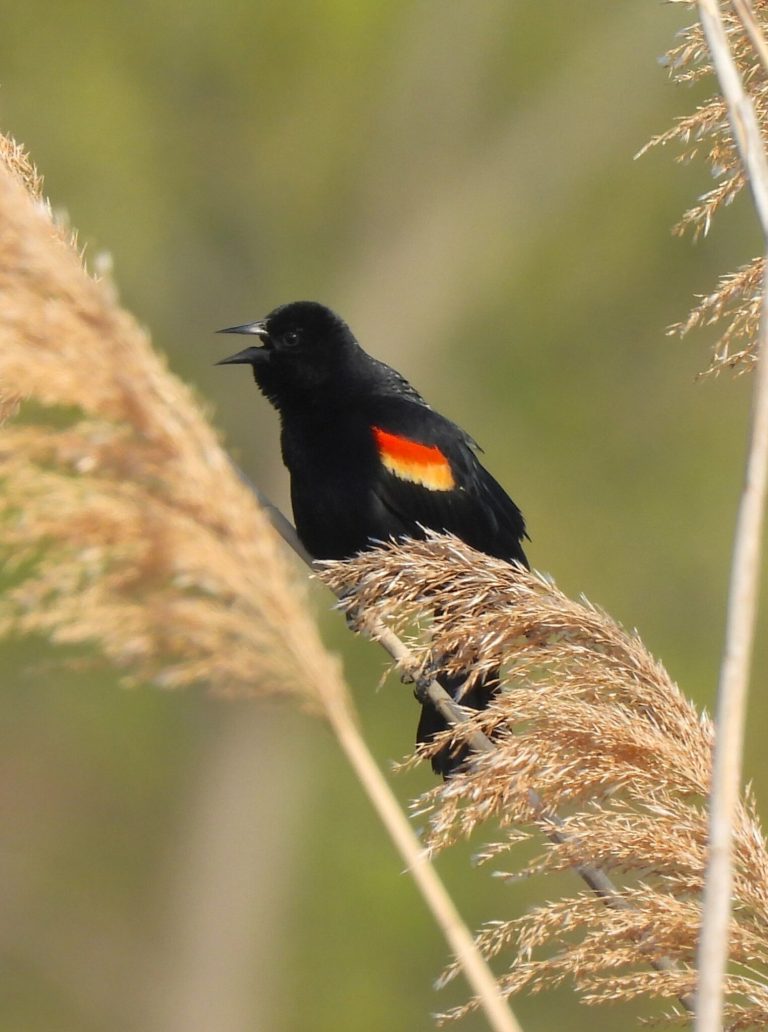
By Jennifer Wilson-Pines
All around are signs that yet another cycle of rebirth has begun. Resident male birds are singing, looking to attract a mate and warning off any intruders from their patch. Early migrants are showing up in parks, preserves and backyards.
The male Red-wing Blackbirds, Common Grackles and Cowbirds have arrived in a squawking, trilling, feeder hogging wave. The ladies will follow more sedately in a few weeks. A few early warblers are sending birders scrambling to see them, even though the high tide of migration is still a few weeks away, in mid-May.
Bird migration has more to do with food resources than fluffy, cold-resisting feathers. Most migrants are insect eaters like the warblers. Our year-round resident backyard birds tend to be mostly seed eaters or omnivores: Cardinals, Blue Jays, Goldfinch, House Finch, Woodpeckers. Fruit eaters like Robins slowly eat their way south, only leaving an area when they’ve stripped every berry, and in spring they supplement their diet with insects and invertebrates.
Other fruit eaters such as Orioles head to South America, only returning to nest when there is available food like the early fruiting native Juneberry tree, aka Amelanchier. Other fruit- eating birds like Northern Mockingbirds have discovered suet feeders, as have insectivores like Carolina Wrens and even Ruby-crowned Kinglets. This rich source of fat and protein allows them to overwinter.
Shorebirds and waterfowl have similar needs, heading to their northern breeding areas in the boreal forest and tundra lakes and ponds, depending on the vibrant short summer packed with insect hatches and fast-growing plants to raise their offspring. Already the migratory Canada Geese are returning north, and Scaup, Bufflehead, Mergansers, Scoters, Long-tails and Ruddy ducks have vanished from our ponds, bays, the Sound and ocean.
Shorebirds are beginning to arrive in our marshes, feeding up before continuing north. Some of these choose to breed here on the Island. Nickerson beach boasts a huge Common Tern Colony, plus American Oystercatchers and Black Skimmer. A large percentage of the endangered Piping Plover population nests on Long Island beaches. The Threatened Least Terns also breed in small colonies.
Why birds migrate might seem obvious – going to where the best food resources are located during the hectic breeding season improves success, but it’s much more complex. A prevalent theory is that over hundreds of thousands of years as waves of glaciers advanced and receded, birds would venture into newly ice-free areas in search of food, and these ventures became established in the populations.
But there are also migration dropouts, tropical species that don’t venture north and northern species who have found ways to survive the winter. There are species that have been expanding their northern range within our lifetimes. In the 1950’s a Cardinal would have been a rare bird in our area. Twenty years ago, Carolina Wrens didn’t overwinter on Long Island. Northern Mockingbirds, despite the name, are southern birds that have only established year-round over the last 20-plus years.
Boat-tailed Grackles have established substantial summer breeding populations along the south shore of Long Island within the last 10 years. Some of these changes may be driven by climate change, and the Audubon Society has a climate project underway to try and determine if the changes in range of certain species is linked to global warming.
Climate change is just one of the hazards faced by birds all over the world. The billions of birds lost over the last few decades can be placed squarely at our feet ——destruction of habitat, massive use of pesticides and herbicides, feral cats, building collisions, competition for resources, and urban light traps take a toll of millions of birds every year and migration is a peak of vulnerability.
What can you do? Provide food in the form of native plants with seed, fruit and insect- attracting flowers. If you have a feeder, it should either be close to a window (within 3 feet) or far away to prevent collisions. There are clear appearing-to-us stickers that can be placed on windows to make them visible to birds. Keep your cats indoors, and do not encourage or feed feral cats. During dry spells a source of fresh water can be critical.
Don’t spray. There are more planet friendly ways of dealing with pest insects and weeds —— and “scary” doesn’t make it a pest. Enjoying our beautiful, feathered friends and helping to protect them from the perils they face is simple and important. Like the canaries carried into coal mines to warn miners of dangerous conditions, birds are warning us that we, too, are endangered if we continue on our current path.






